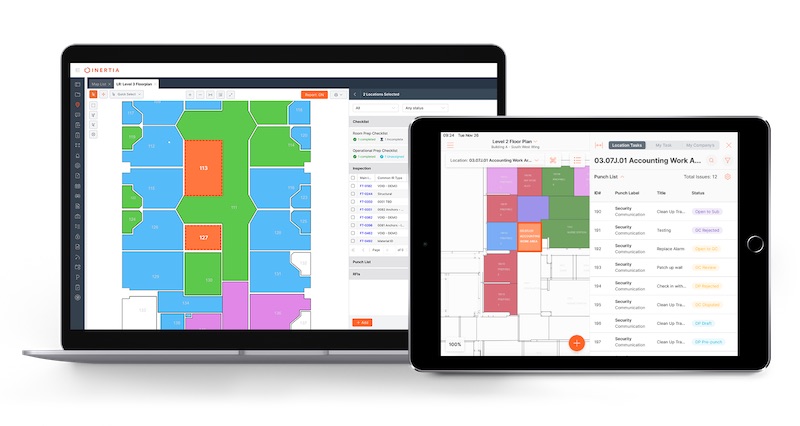San Diego-based Inertia Systems today officially announces the launch of Inertia Platform, a cloud-based SaaS enterprise construction management platform that automatically connects and coordinates teams, processes, project and quality management through BIM and smart drawings.
The 10-year-old company, whose marketing tagline is “Closing the loop from design to built,” is introducing its platform at a time when the construction sector is still determining how best to use jobsite technology to improve productivity. A recent FMI Corp.-PlanGrid report estimated that construction overages and rework result in $177.5 billion in wasted labor costs annually in the U.S. alone.
Most project management software is list-based cloud collaboration, explains Matthew Hudelson, Inertia Systems’ CEO. What differentiates his company’s product is its “pivot to a location-based platform that leverages information from the BIM model.”
Generated automatically based on designs, each record created in the platform is automatically attached to its physical location on the project map and updated wherever designs change. Inertia Platform uses patent-pending technology to connect information from every solution and Building Team member (including contractors, owners, engineers and architects) throughout every phase in real time, ensuring all information stays connected and up to date throughout the construction process.
PLATFORM PROVIDES COMPLIANCE VERIFICATION

Among Inertia Platform's functions is the ability to create real-time mobile punchlists.
What’s unique about this software, Hudelson goes on, is that it provides collaborative information for Project Management, Quality Management, Performance Management, and Compliance Management. That last function is critical in California’s healthcare sector, which is highly regulated and where construction managers must prove to inspectors that their work complies with the state’s codes. “Inertia makes this information accessible quickly,” he says.
To develop its Inertia Platform, Inertia Systems has worked with leading construction management firms that include Turner Construction, McCarthy Building Companies, Clark Construction, Kiewit Construction, and AECOM. “We’ve worked alongside builders, owners, inspectors, architects, and team members to learn how our tools and workflows impact challenges they face and, in turn, learned to address their varying needs and inefficiencies in scalable ways throughout every single step of the construction process,” says Hudelson.
Inertia Systems has been used by dozens of owners and GCs in the healthcare, education, and sports and entertainment sectors. The projects it contributed to include the Lucile Packard Children’s Hospital Stanford, Scripps Prebys Cardiovascular Institute, Sutter Health California Pacific Medical Center Van Ness Campus Hospital, and a major NFL stadium.
Related Stories
| Nov 5, 2010
New Millennium’s Gary Heasley on BIM, LEED, and the nonresidential market
Gary Heasley, president of New Millennium Building Systems, Fort Wayne, Ind., and EVP of its parent company, Steel Dynamics, Inc., tells BD+C’s Robert Cassidy about the Steel Joist Manufacturer’s westward expansion, its push to create BIM tools for its products, LEED, and the outlook for the nonresidential construction market.
| Nov 3, 2010
Sailing center sets course for energy efficiency, sustainability
The Milwaukee (Wis.) Community Sailing Center’s new facility on Lake Michigan counts a geothermal heating and cooling system among its sustainable features. The facility was designed for the nonprofit instructional sailing organization with energy efficiency and low operating costs in mind.
| Nov 3, 2010
Virginia biofuel research center moving along
The Sustainable Energy Technology Center has broken ground in October on the Danville, Va., campus of the Institute for Advanced Learning and Research. The 25,000-sf facility will be used to develop enhanced bio-based fuels, and will house research laboratories, support labs, graduate student research space, and faculty offices. Rainwater harvesting, a vegetated roof, low-VOC and recycled materials, photovoltaic panels, high-efficiency plumbing fixtures and water-saving systems, and LED light fixtures will be deployed. Dewberry served as lead architect, with Lord Aeck & Sargent serving as laboratory designer and sustainability consultant. Perigon Engineering consulted on high-bay process labs. New Atlantic Contracting is building the facility.
| Nov 2, 2010
11 Tips for Breathing New Life into Old Office Spaces
A slowdown in new construction has firms focusing on office reconstruction and interior renovations. Three experts from Hixson Architecture Engineering Interiors offer 11 tips for office renovation success. Tip #1: Check the landscaping.
| Nov 2, 2010
A Look Back at the Navy’s First LEED Gold
Building Design+Construction takes a retrospective tour of a pace-setting LEED project.
| Nov 2, 2010
Wind Power, Windy City-style
Building-integrated wind turbines lend a futuristic look to a parking structure in Chicago’s trendy River North neighborhood. Only time will tell how much power the wind devices will generate.
| Nov 2, 2010
Yudelson: ‘If It Doesn’t Perform, It Can’t Be Green’
Jerry Yudelson, prolific author and veteran green building expert, challenges Building Teams to think big when it comes to controlling energy use and reducing carbon emissions in buildings.
| Nov 2, 2010
Historic changes to commercial building energy codes drive energy efficiency, emissions reductions
Revisions to the commercial section of the 2012 International Energy Conservation Code (IECC) represent the largest single-step efficiency increase in the history of the national, model energy. The changes mean that new and renovated buildings constructed in jurisdictions that follow the 2012 IECC will use 30% less energy than those built to current standards.
| Oct 13, 2010
Test run on the HP Z200 SFF Good Value in a Small Package
Contributing Editor Jeff Yoders tests a new small-form factor, workstation-class desktop in Hewlett-Packard’s line that combines performance of its minitower machine with a smaller chassis and a lower price.















